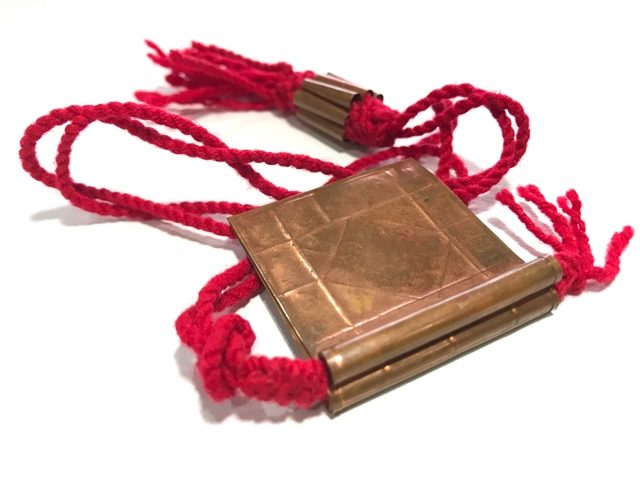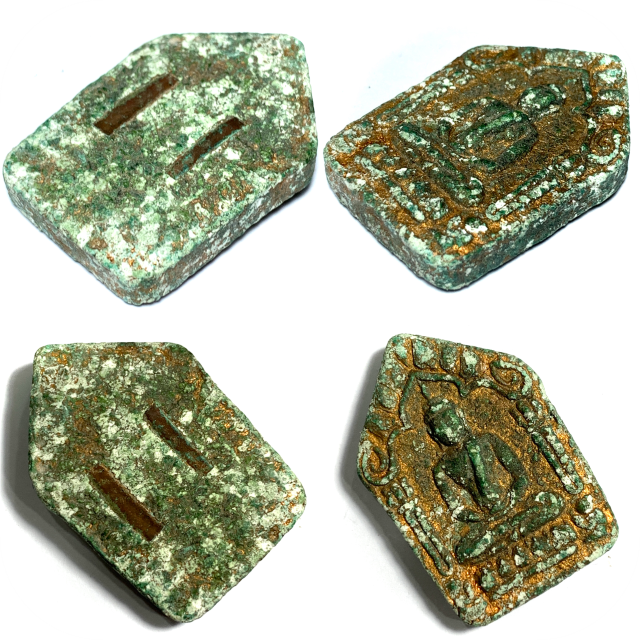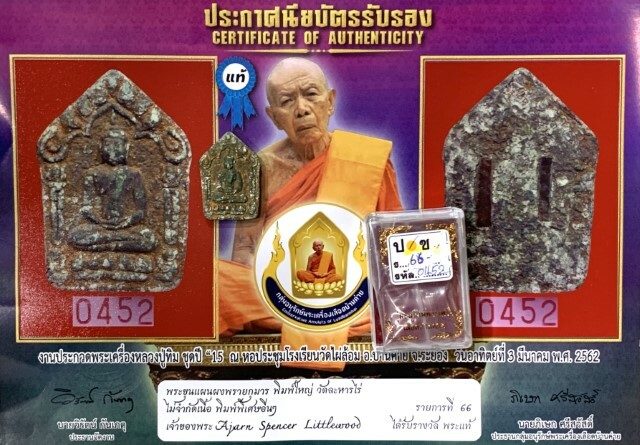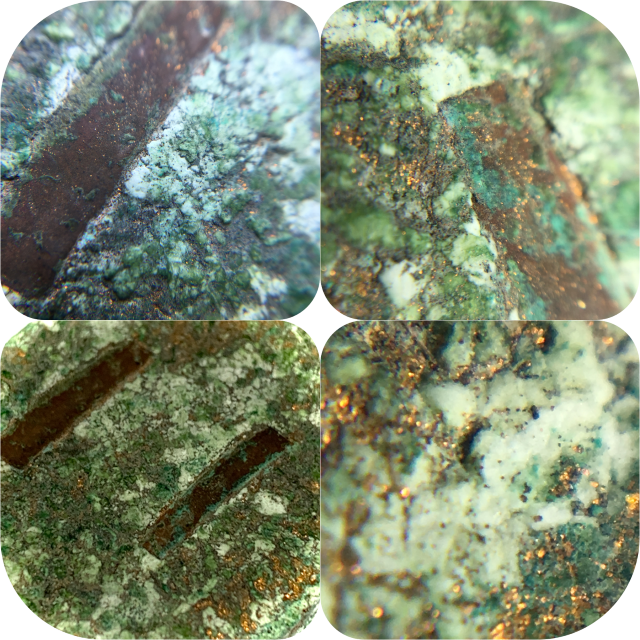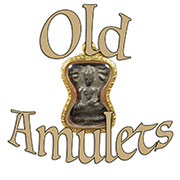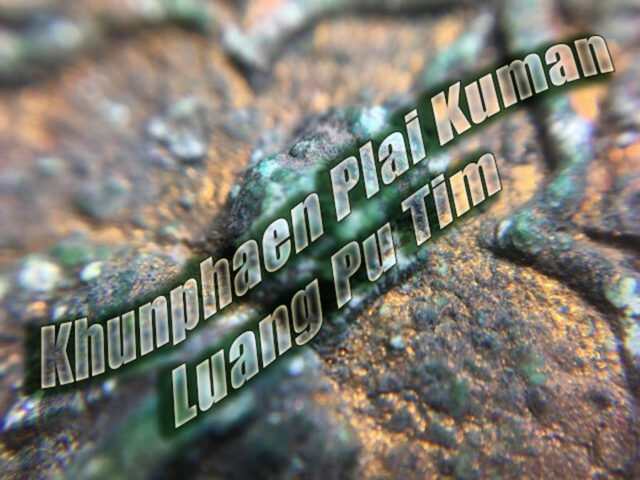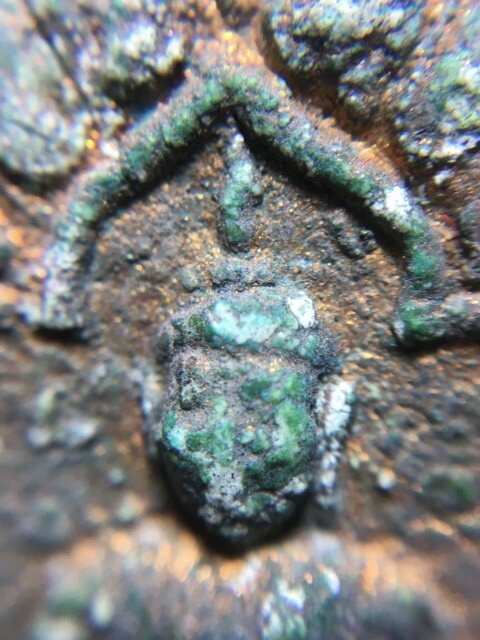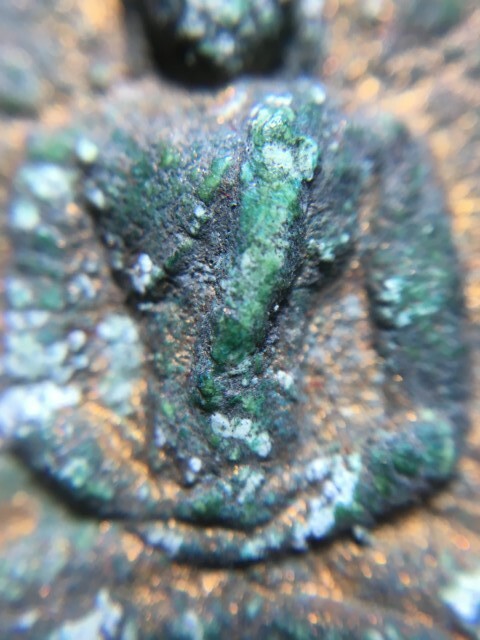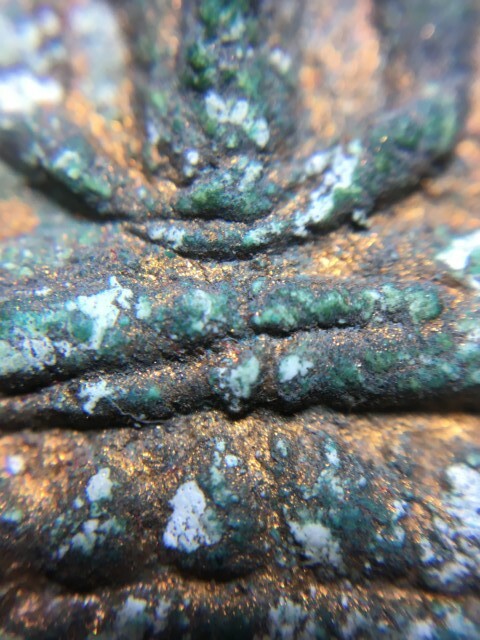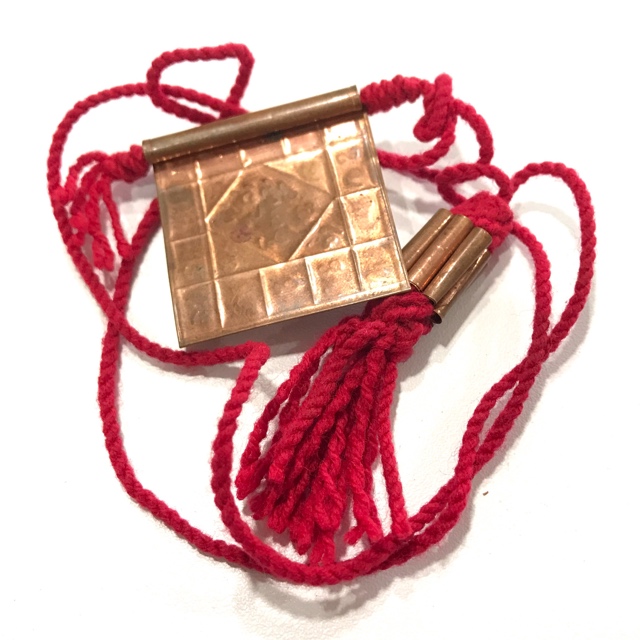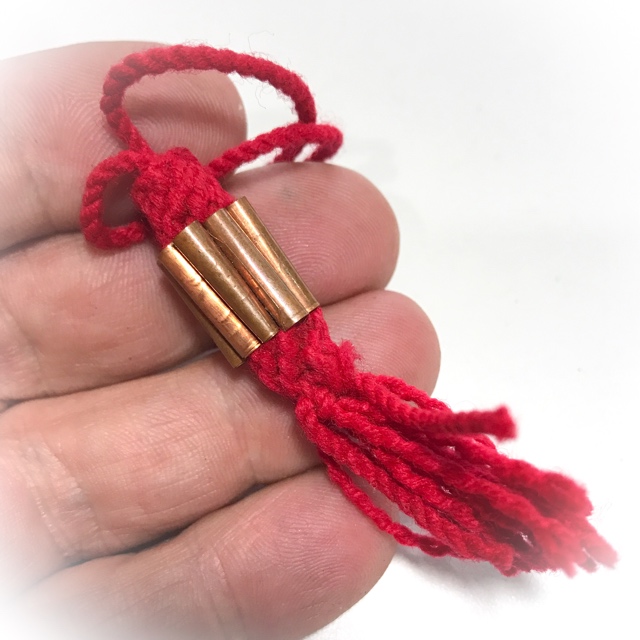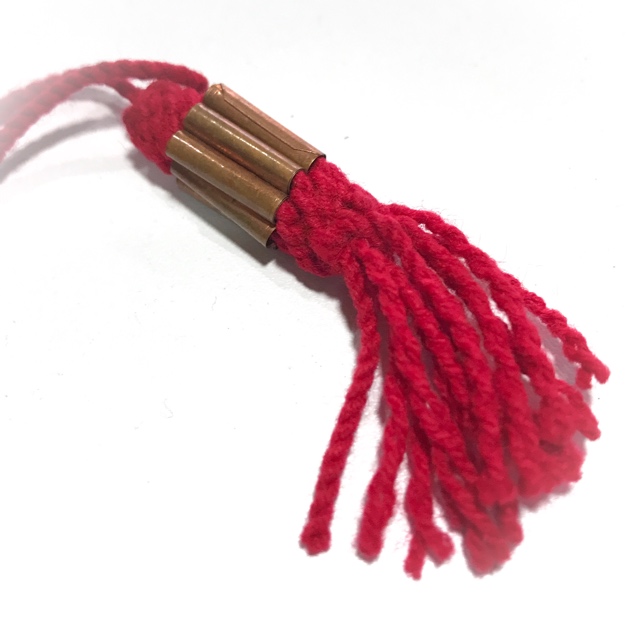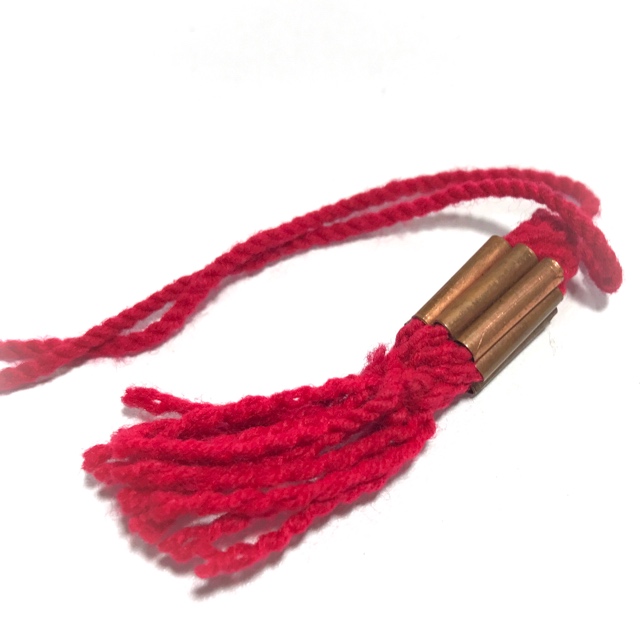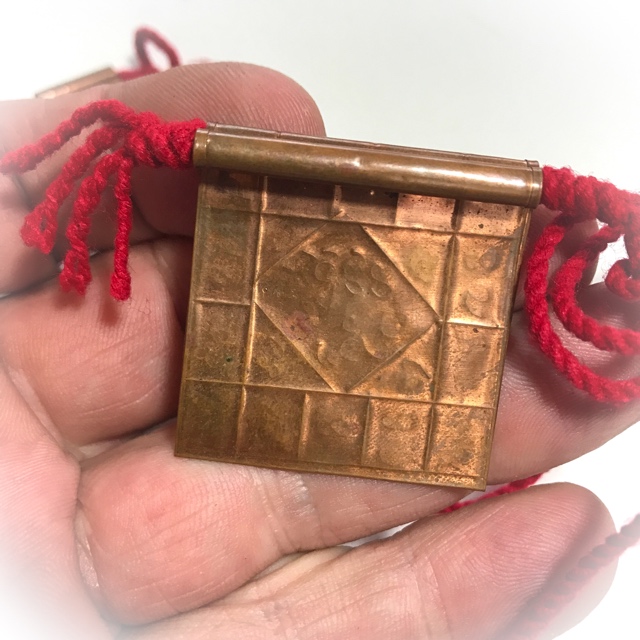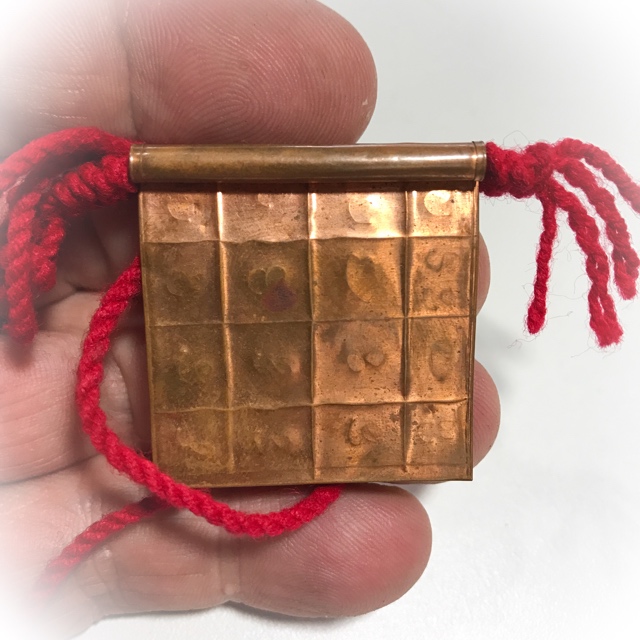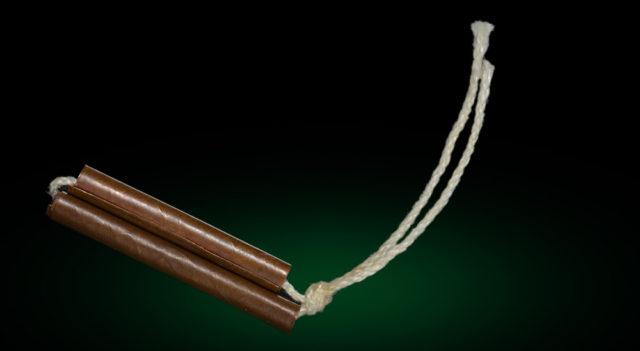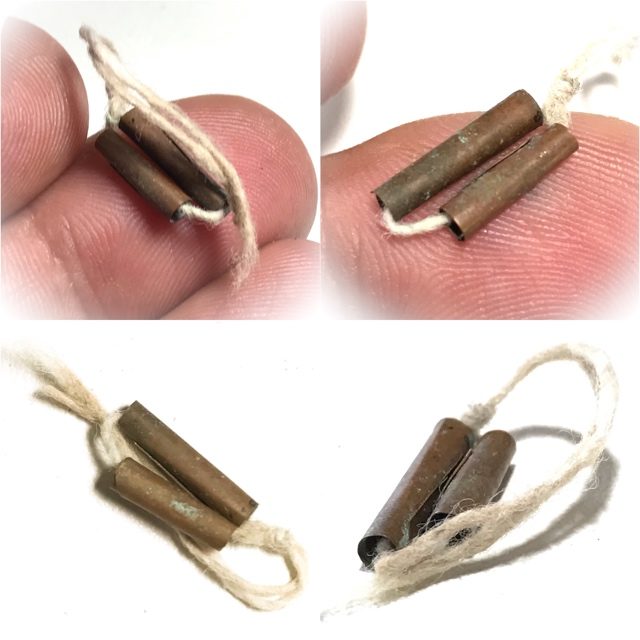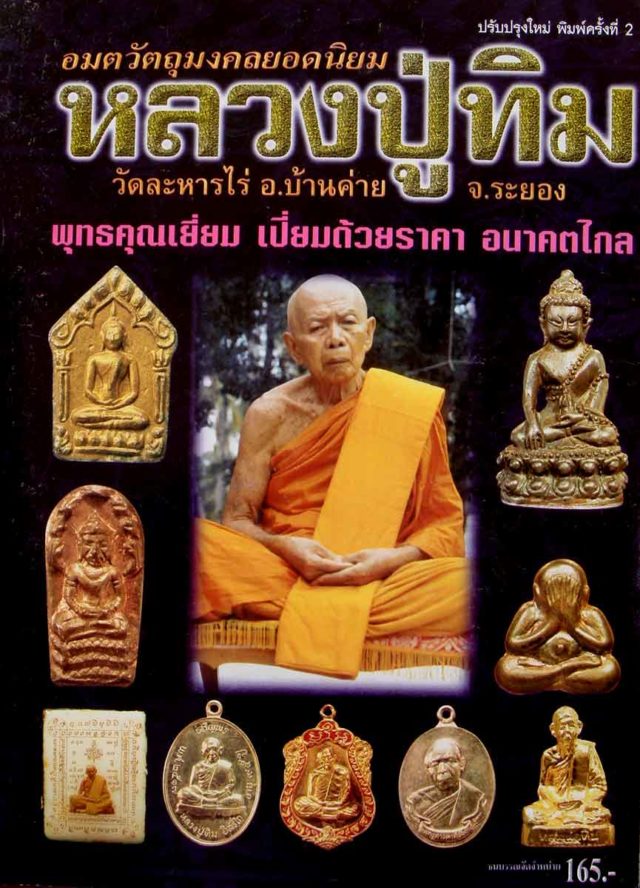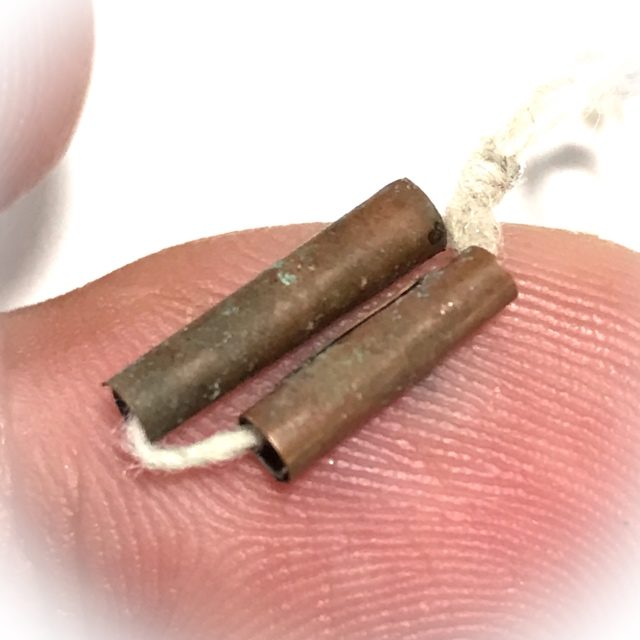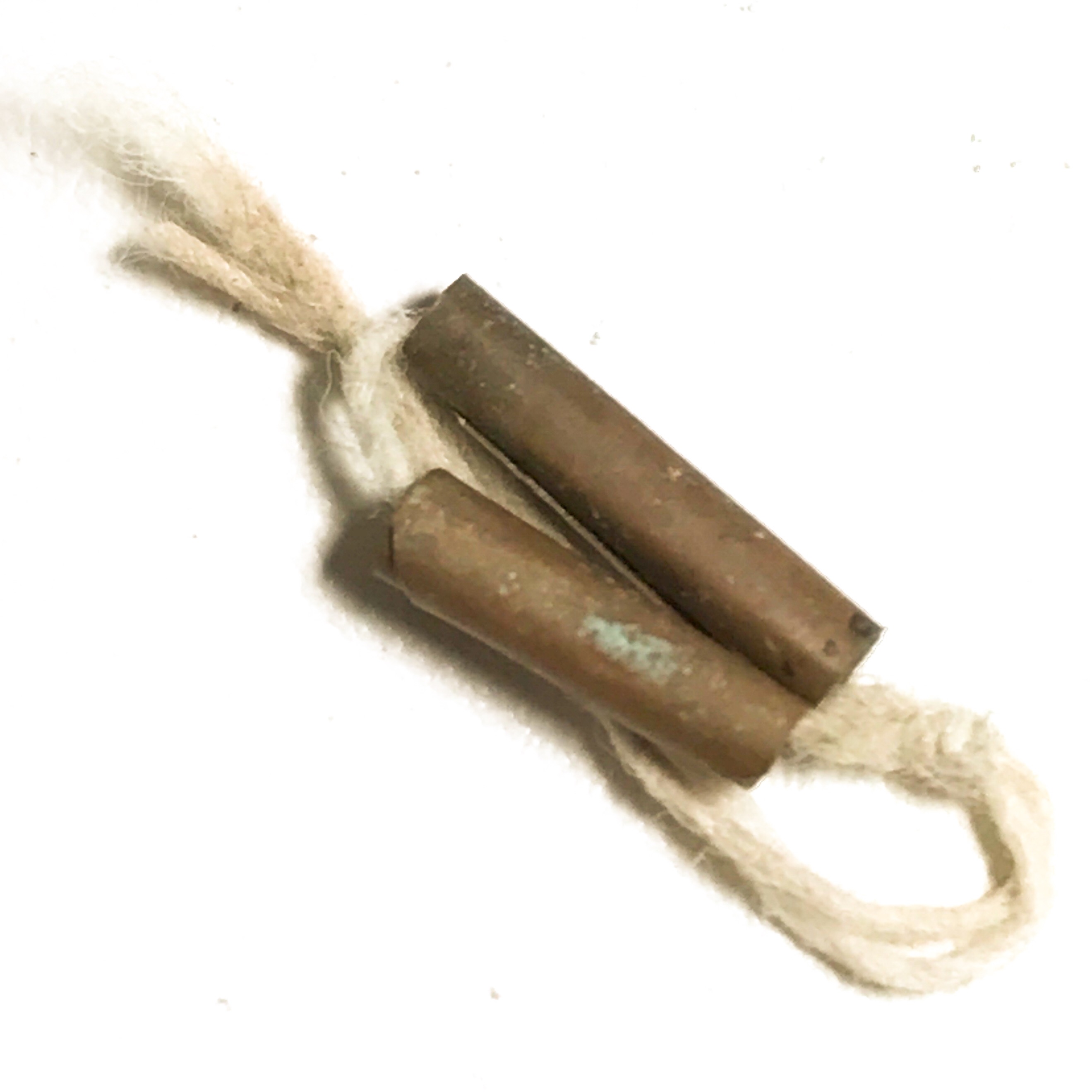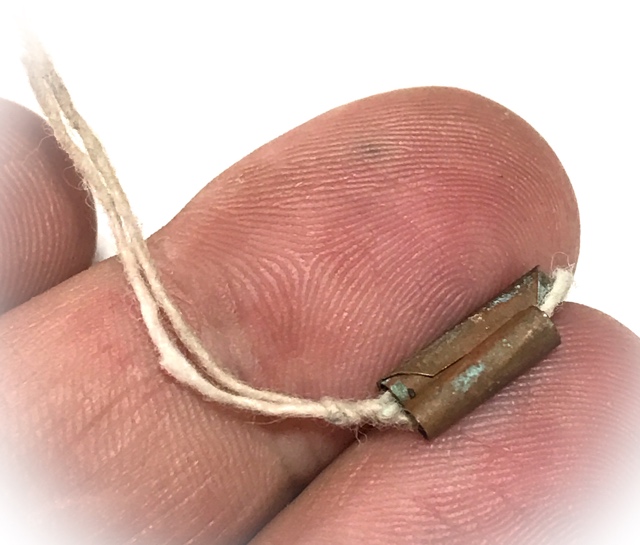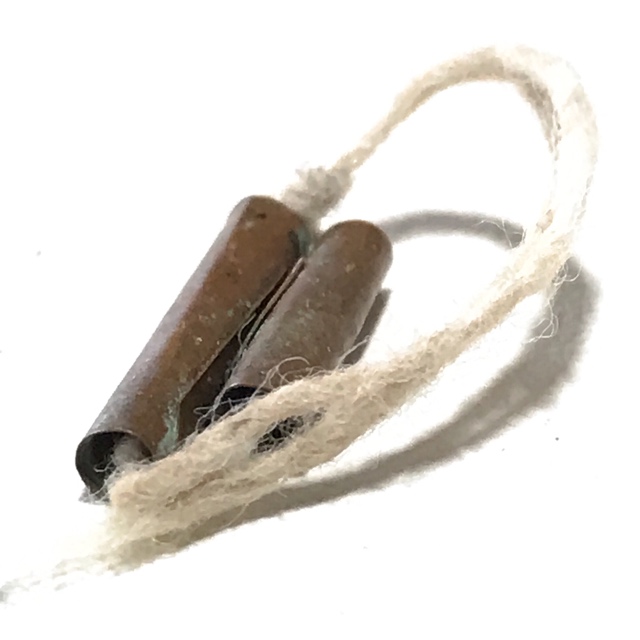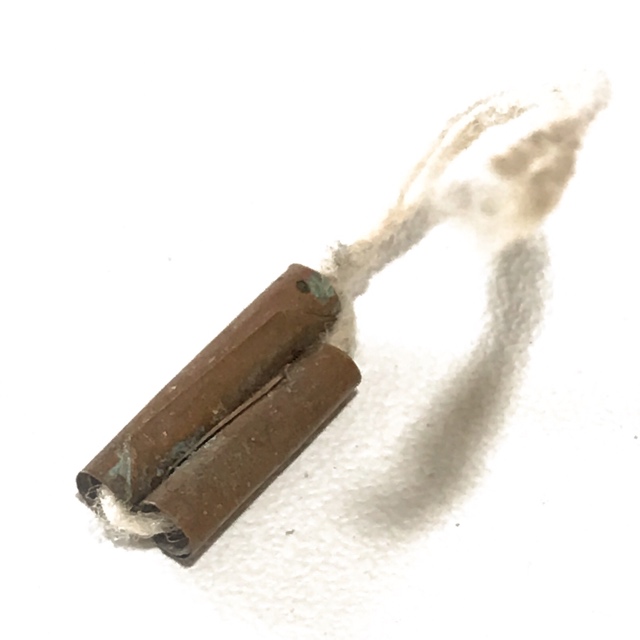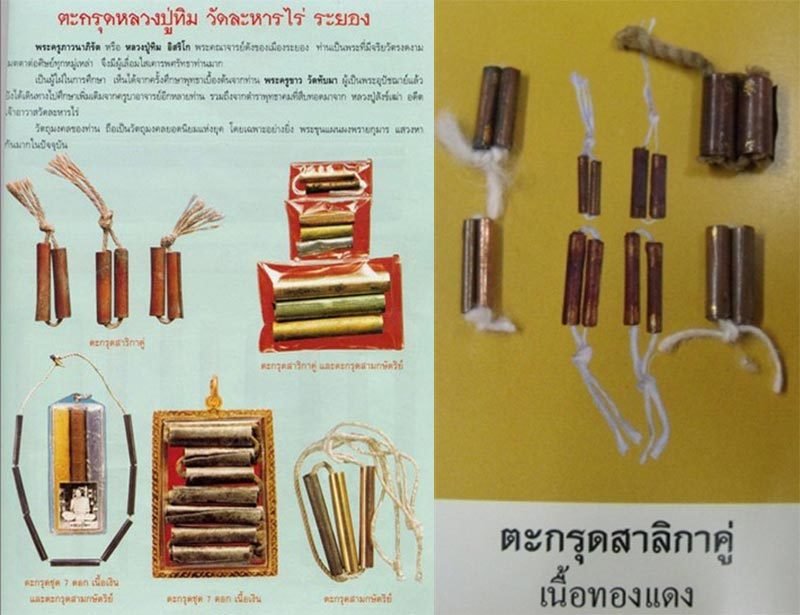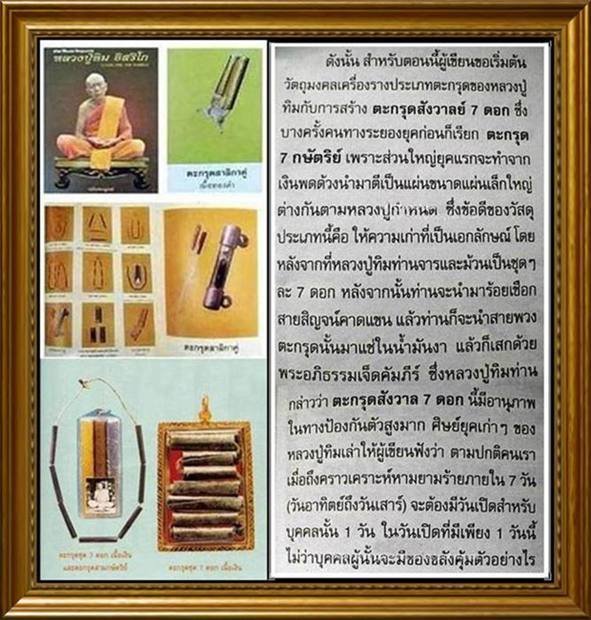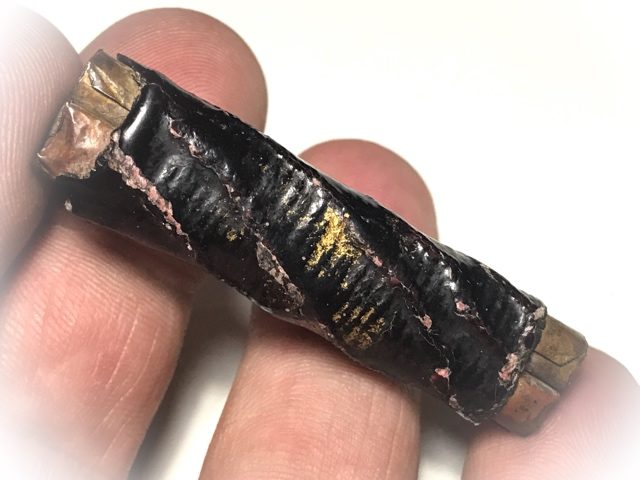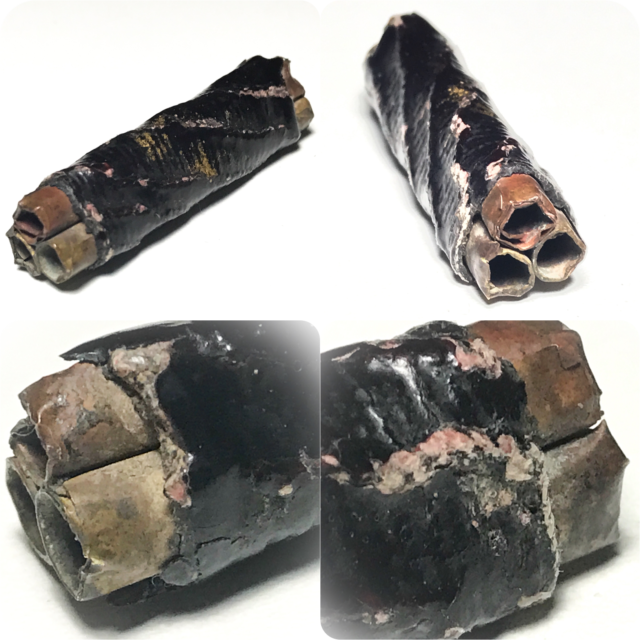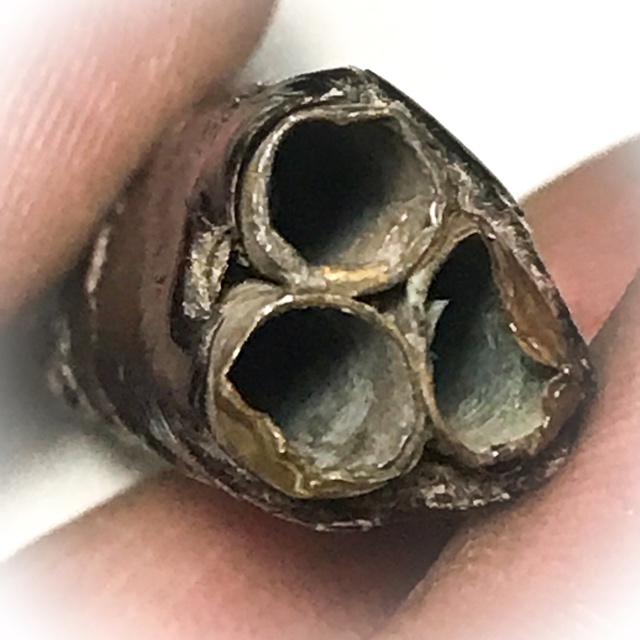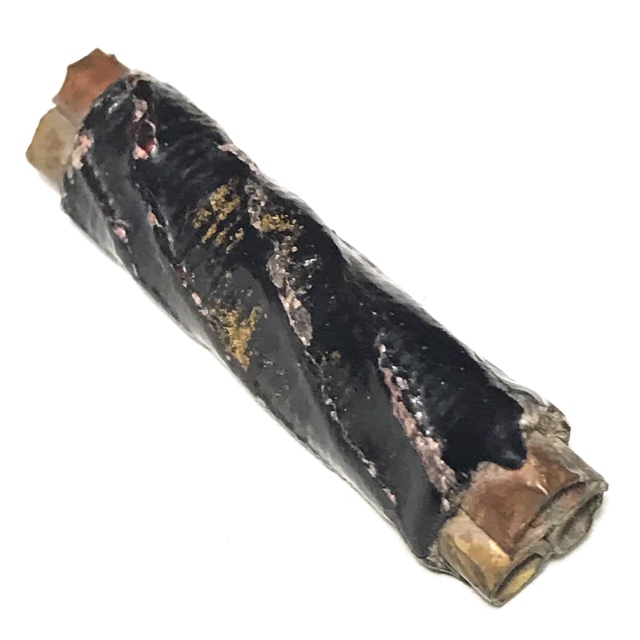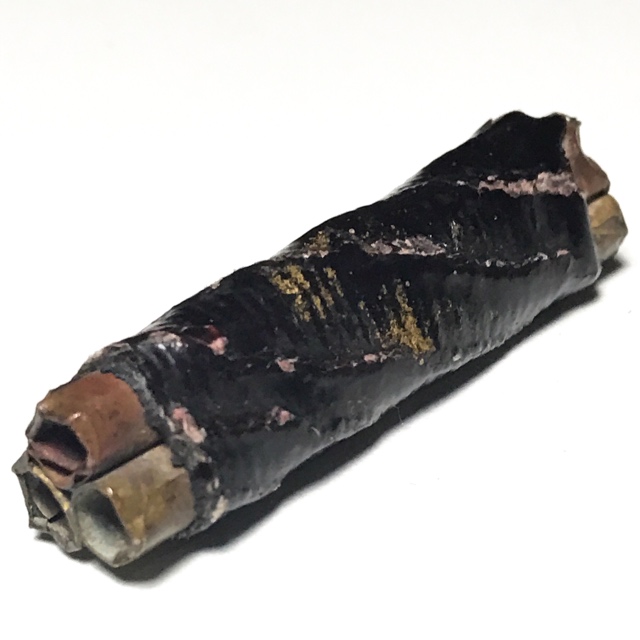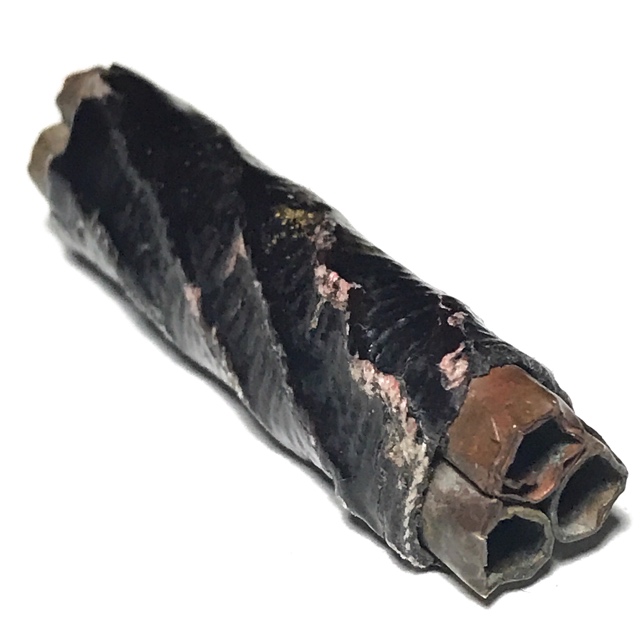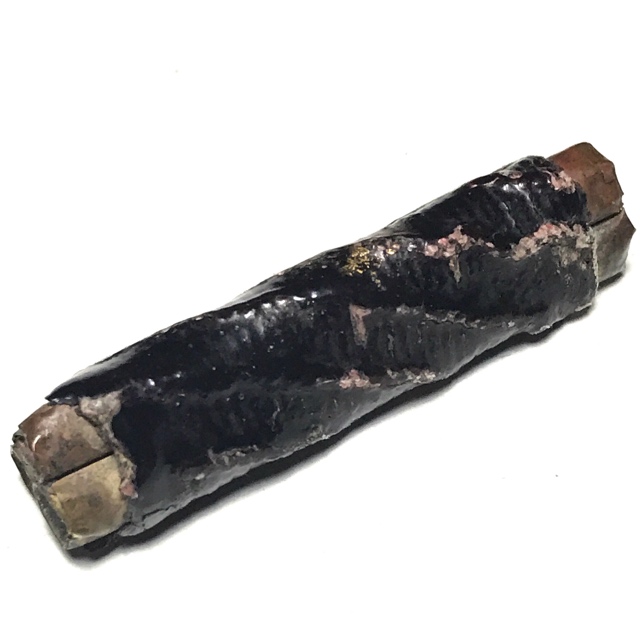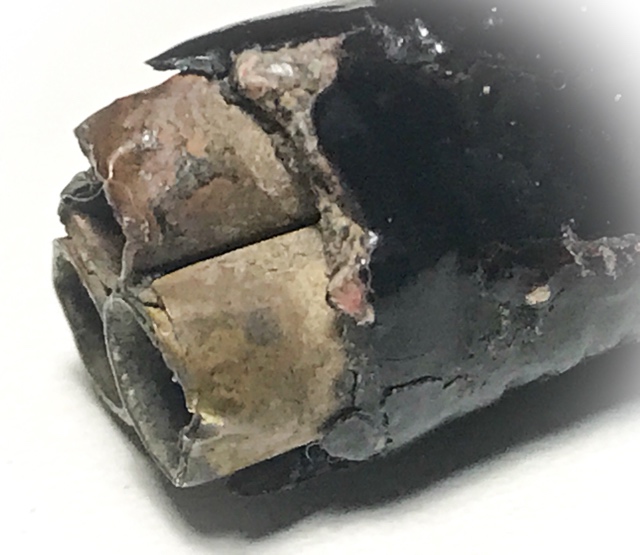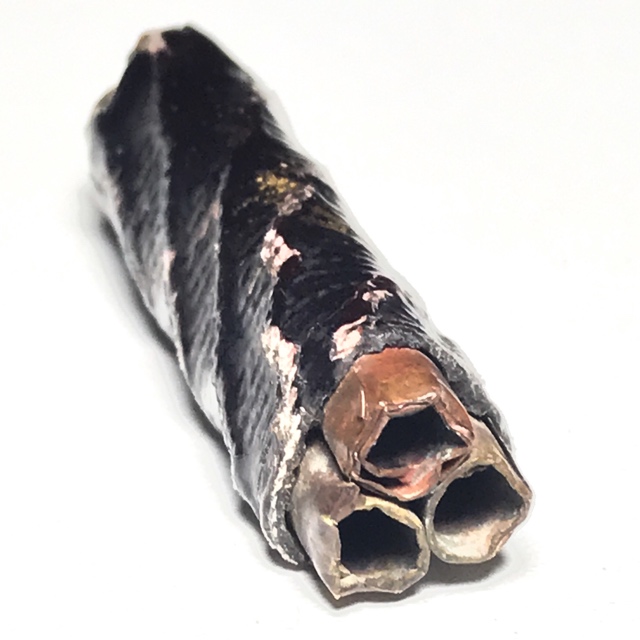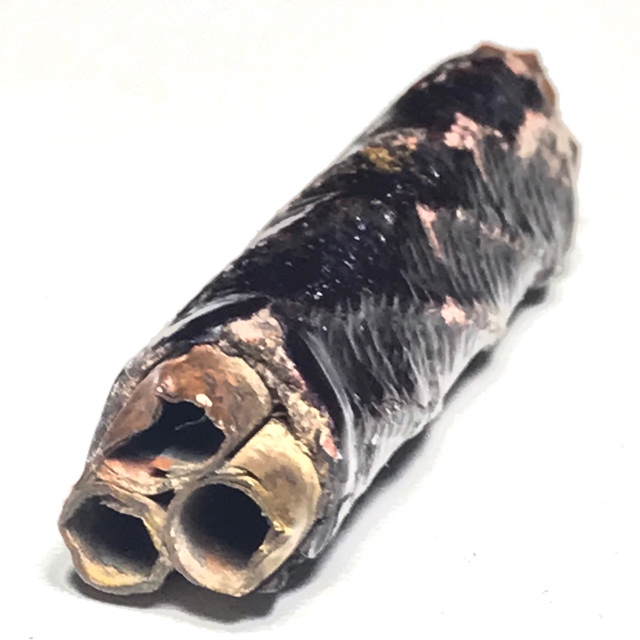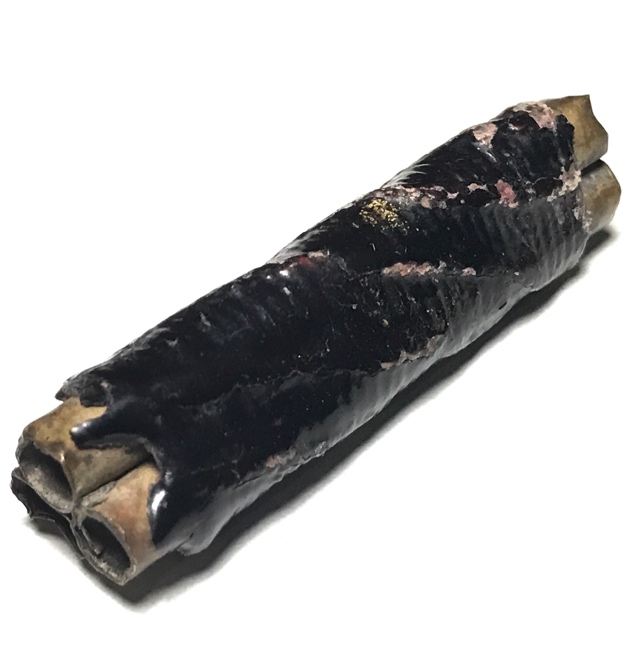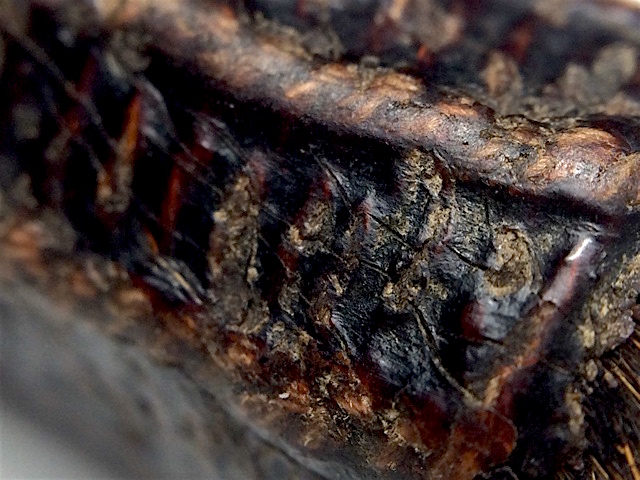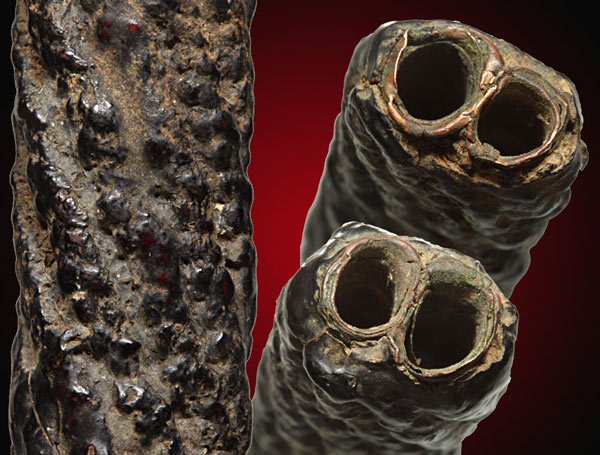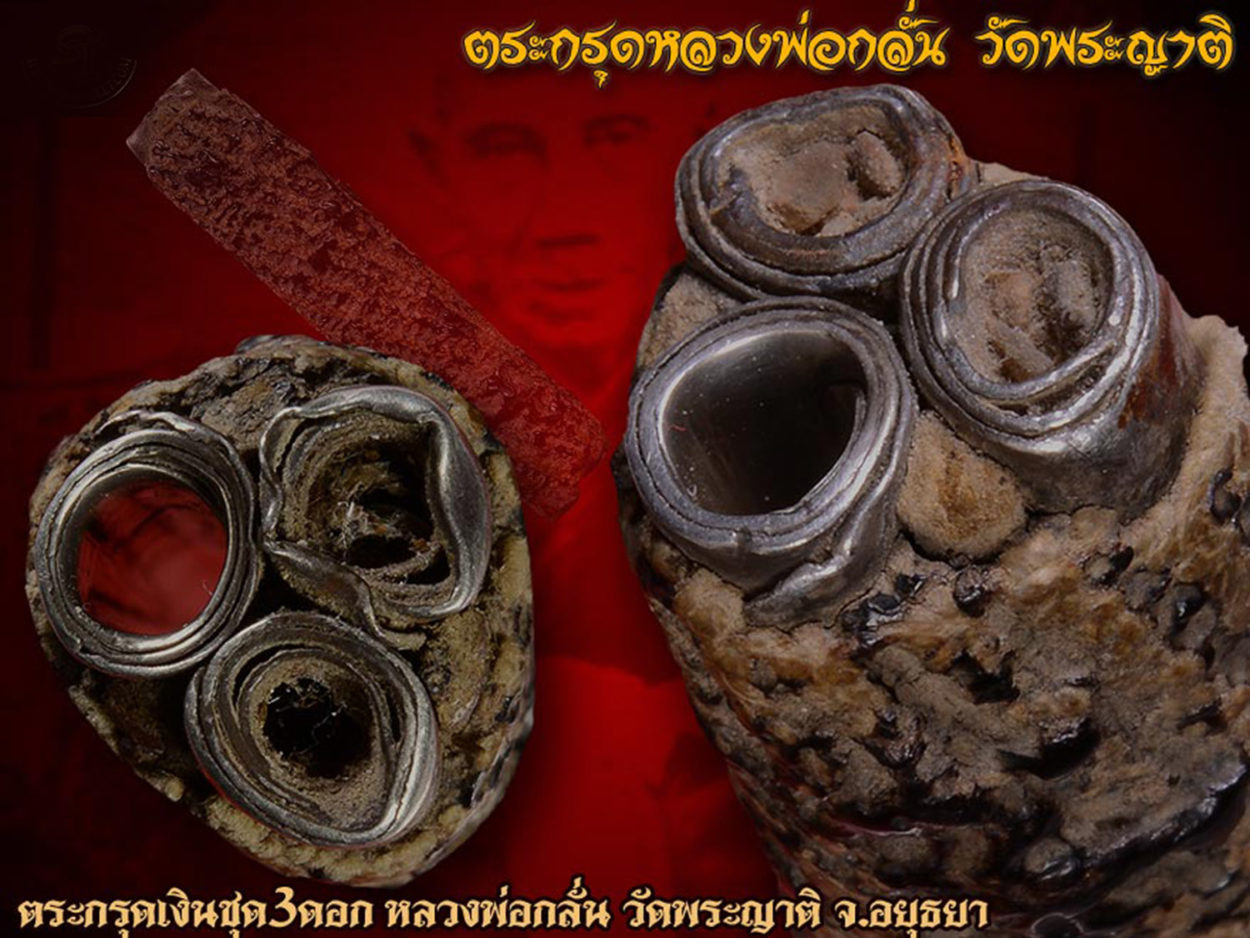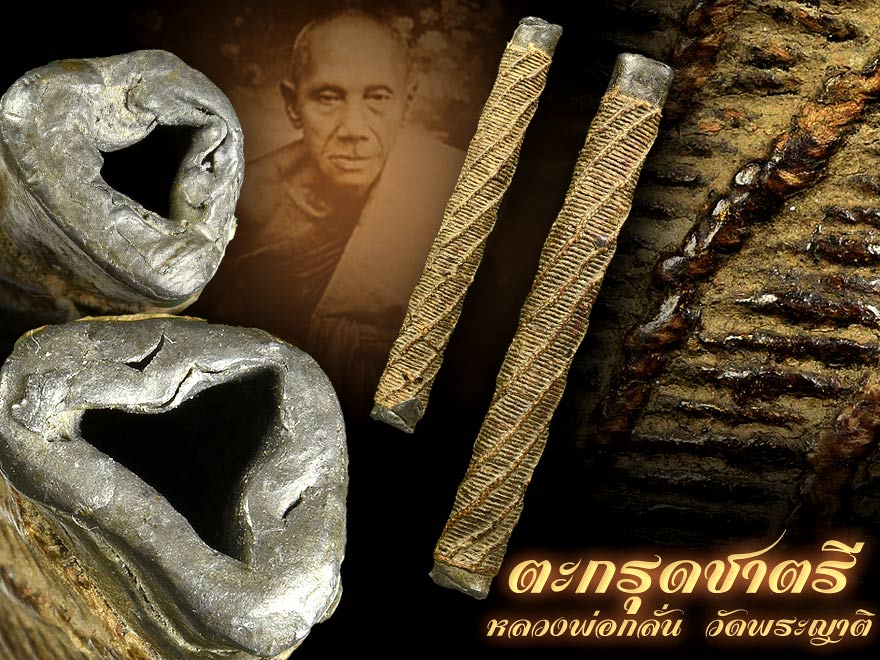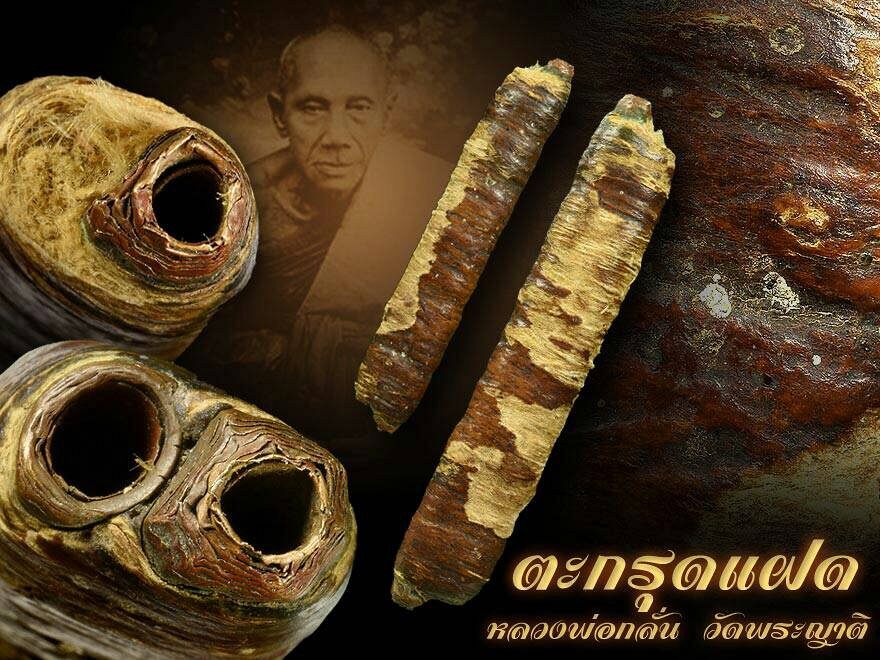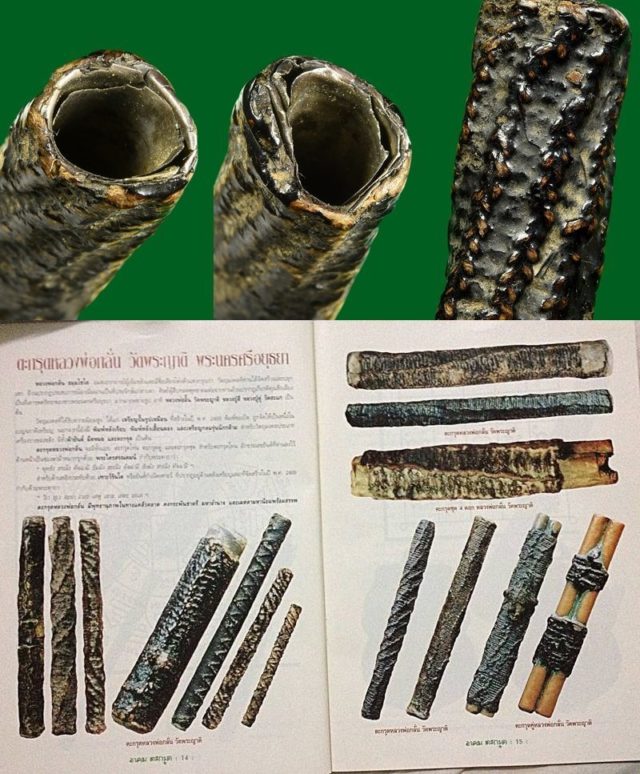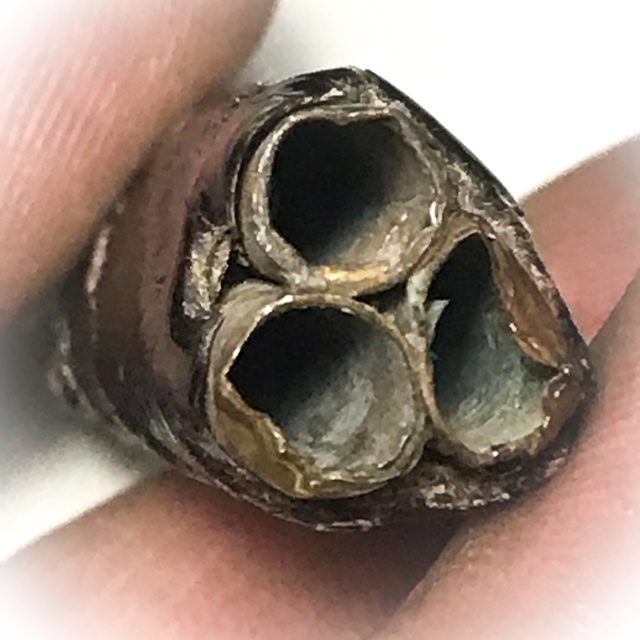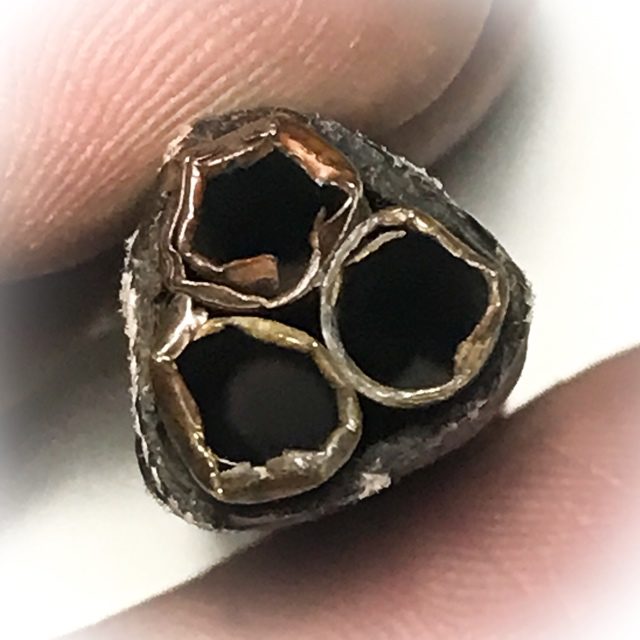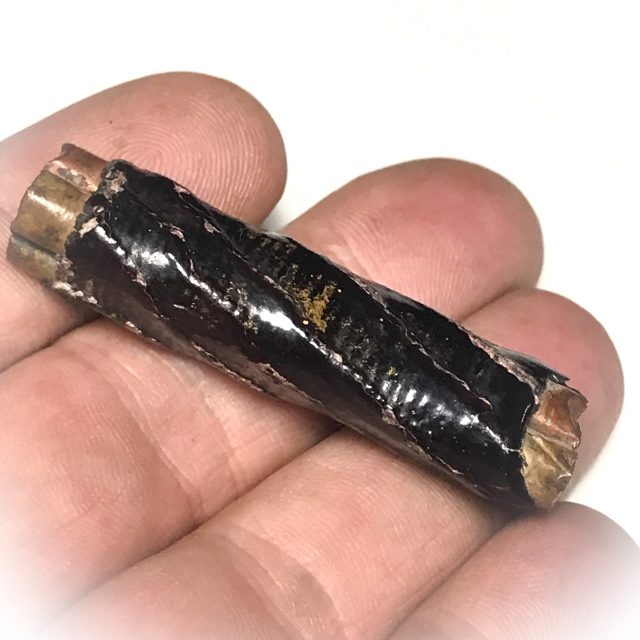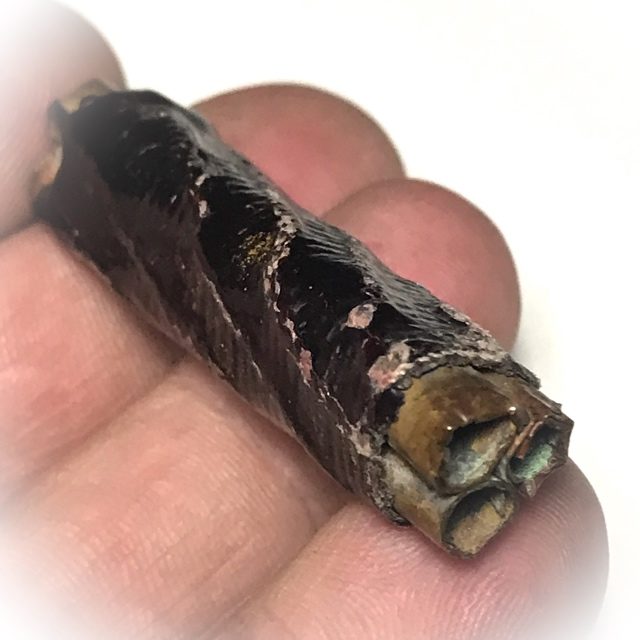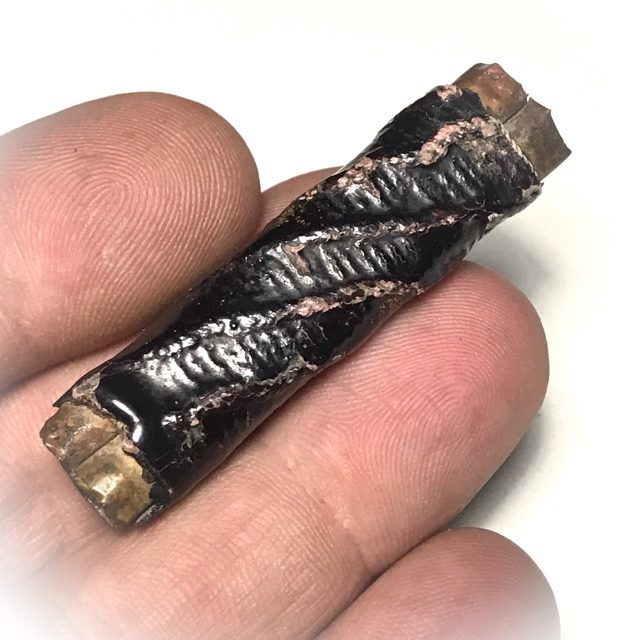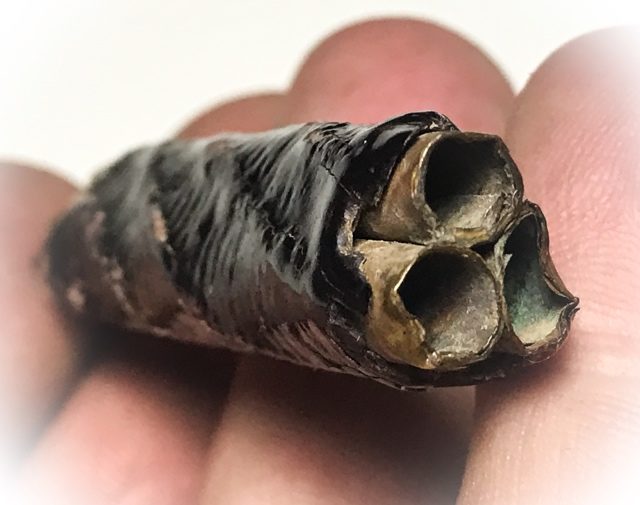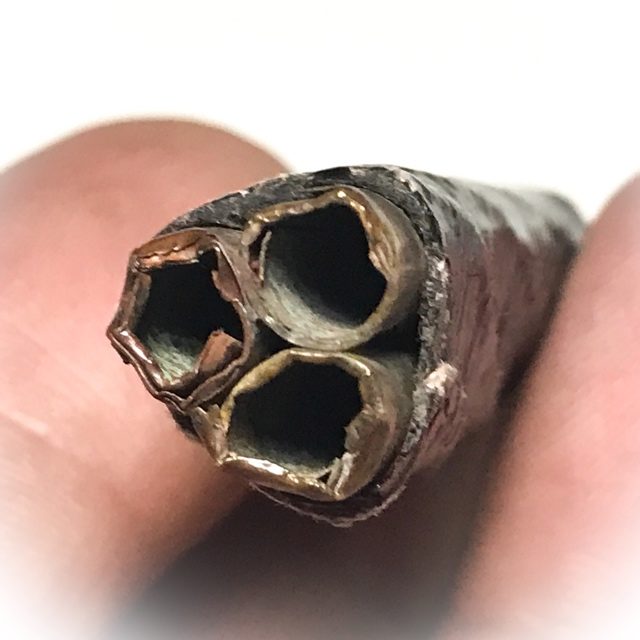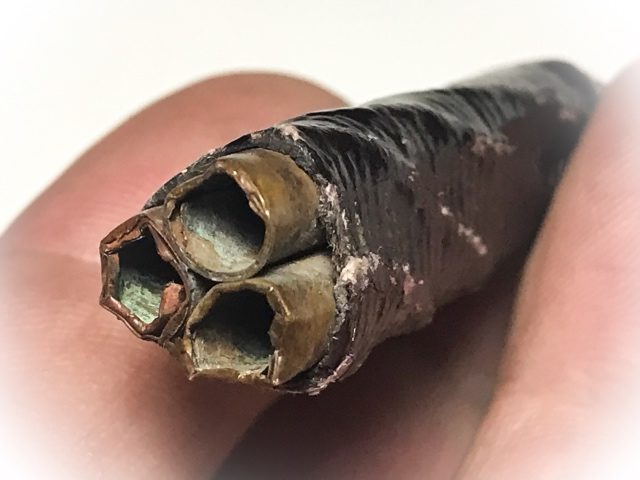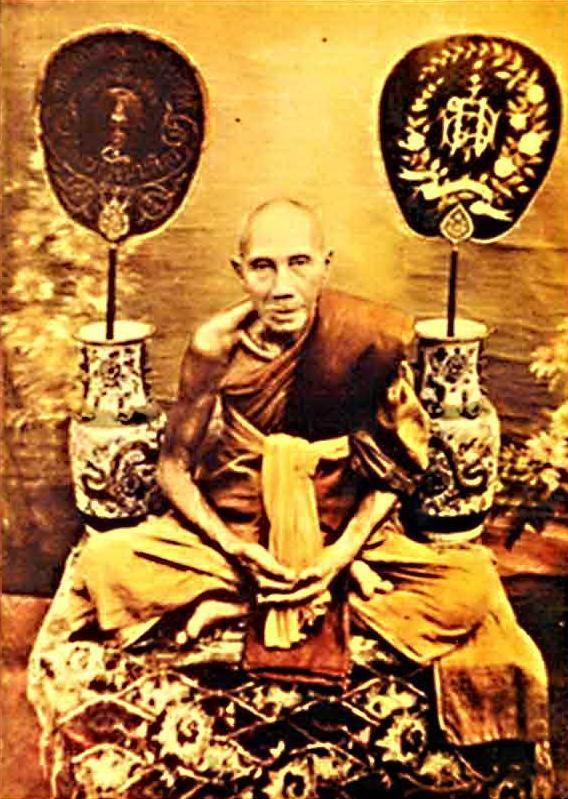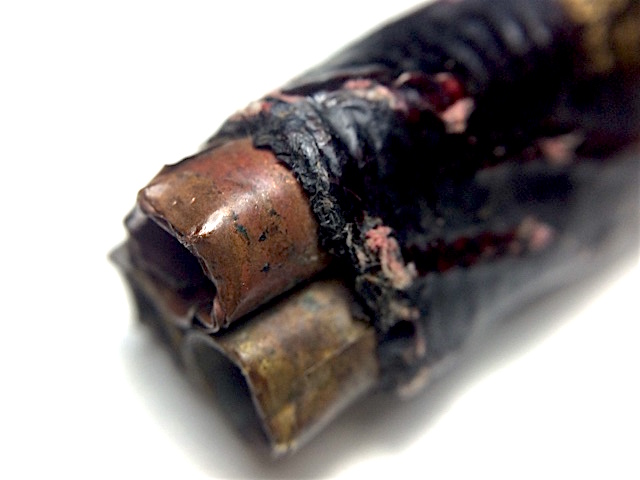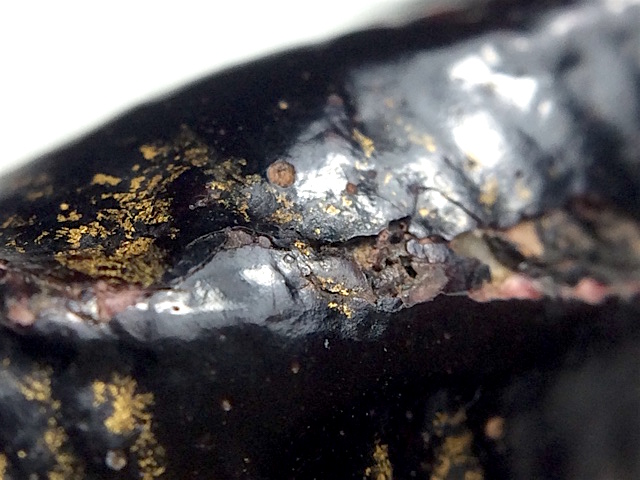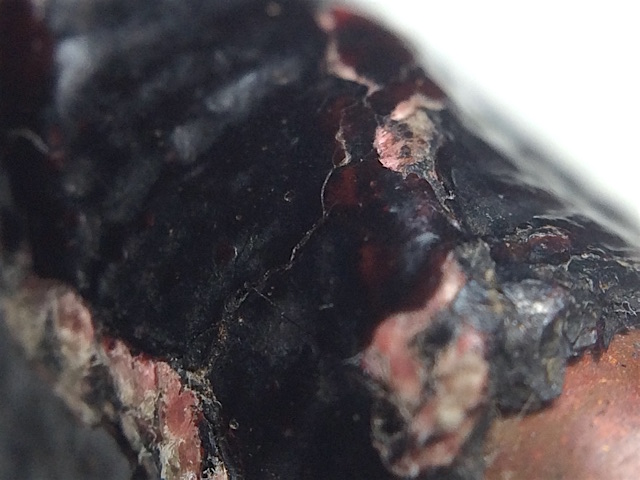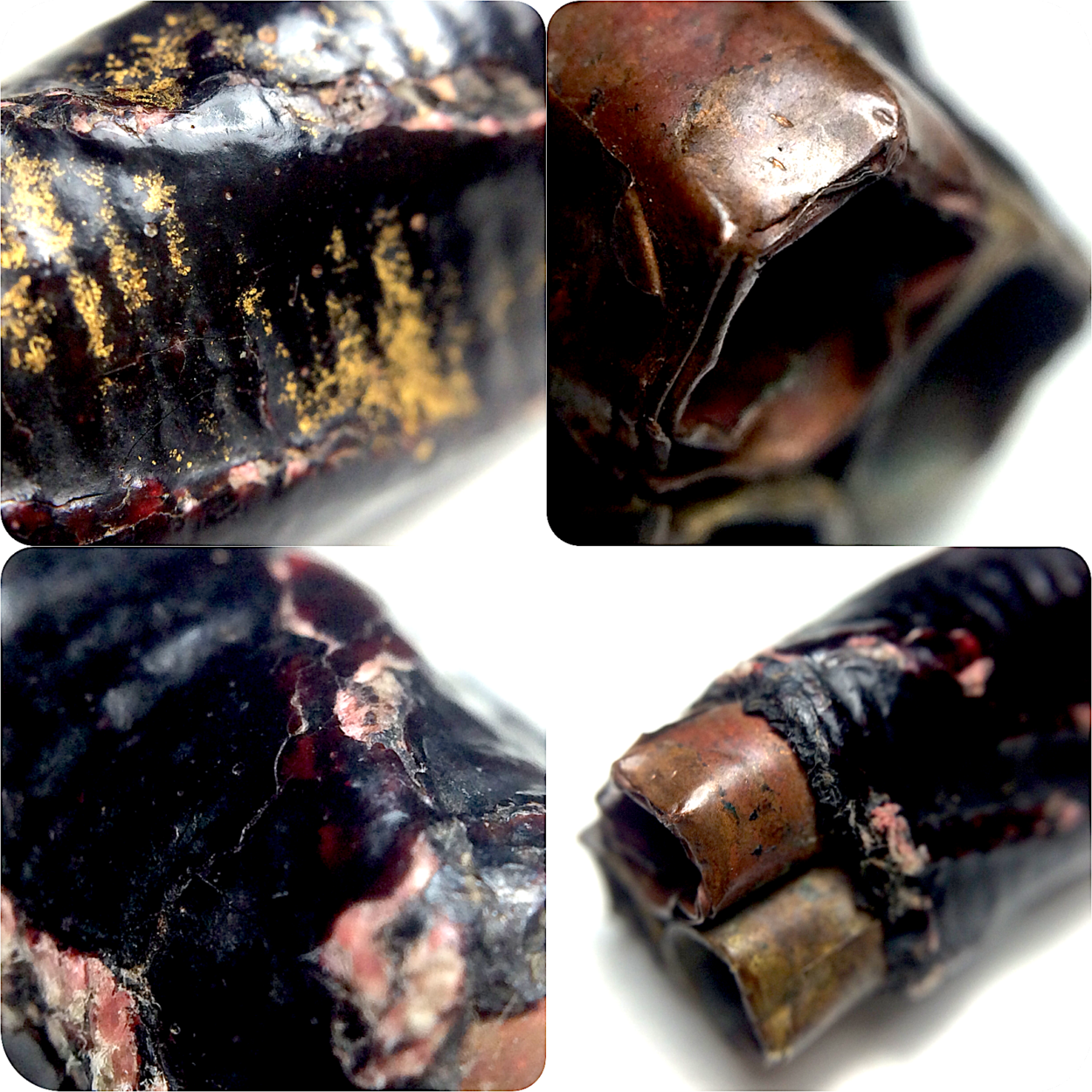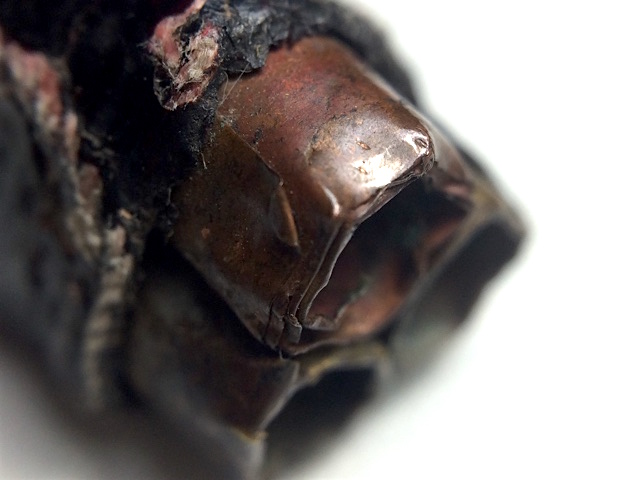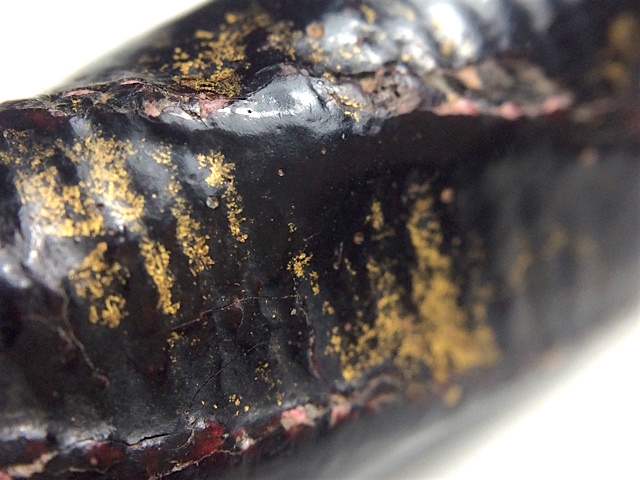Presenting a very rare Twin compendium Wicha, composed of two Classic Lanna Amulets of the Great Thai Guru Master Monk, Kroo Ba Wang. The Compendium consists of two Takrut with Sacred Geometry spells inscribed; the Takrut Gao Gum 9 Ninefold Yantra Spell, with Yant Hneeb folded Yantra Foil attached with enchanted ‘Daay Daeng Akom’ red sorcerer’s cord, empowered with the Ancient Wicha Lanna by the Great Guru Master Monk and Deceased Ex Abbot of Wat Ban Den, Luang Phu Kroo Ba Wang. Estimated made during the late era of Kroo Ba Wang.
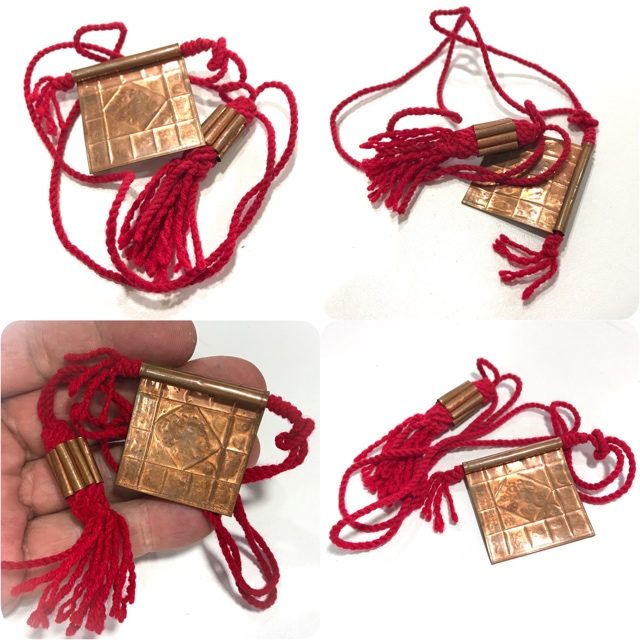
The 9 spells within the Takrut Gao Gum were inscribed individually and empowered and bound into a ninefold Spell, in traditional style of this Northern Lanna Wicha, the this Great Deceased Master of Olden days. The Takrut Gao Gum is Serm Duang, and will give Protection from Danger, and ease your way in life. Business will flourish, money and gifts will flow in, good fortune will come, and life without disturbances. The Yant Hneeb will attract wealth and popularity and even be a seduction spell for specific persons such as an intended lover.
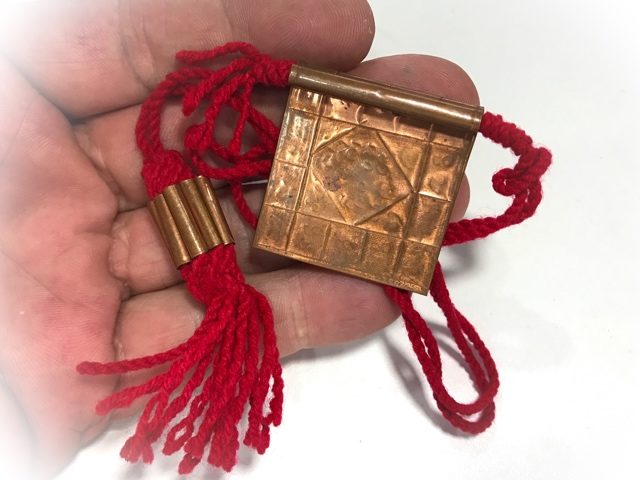
The Takrut Gao Gum is a powerful Sacred Geometry based Talisman containing a myriad of magic spells, which has been used by ancient folk for thousands of years. The Takrut Gao Gum and Yant Hneeb are amongst the rarer and most preferred amulets of the Pantheon of Kroo Ba Wang, and highly regarded for their sacred power of Metta Maha Sanaeh, and Maha Lap, with comprehensive protective powers of Klaew Klaad.
The Yant Hneeb Maha Sanaeh Maha Pokasap is an Ancient Lanna Yantra Foil spell Amulet for seduction and wealth accumulation. The Yant Hneeb can be opened and place a paper or parchment inside with one’s desires, or the name of a person written on it (or hairs or other piece of clothing, or fingernail from the person you desire). The Yant Hneeb is an ancient Lanna Wicha that has been used by the Lanna Folk for centuries, and which has been perpetuated by the Lanna Masters to the present day.
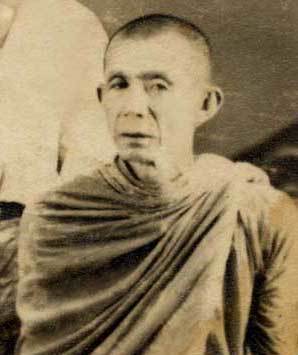
Luang Phu Kroo Ba Wang Wat Ban Den
The Yant Hneeb of Kroo Ba Wang is one of the rarer amulets to find in circulation in the present day, and is a standard-bearer of the Dtamra Krueang Rang Lanna Pantheon of Talismanic Amulets of the Northern Lanna Region. Kroo Ba Wang’s Yant Hneeb can be considered not only a powerful magical Talisman, but also a Historically and Culturally Important Antique Sacred Artifact.
The Ancient Lanna Folk would inscribe the name of a desired lover on a piece of paper, and insert it in the gap between the two folded pieces of Yantra foil, to enchant and summon a person to be attracted and seek the spellcaster.
Alternatively, you can write down your wishes and prayers, and insert them inside the Yant Hneeb, and wait for them to be answered. Once a prayer has been answered, you can then remove it, make some merits in thanks, and insert the next wish, It is said that one should not pray for things within reason, and not be too greedy when making wishes. The Yant Hneeb is imbued with Powerful Maha Sanaeh, and Sarapat Neuk Magic, to attract and enchant others, and to fulfill wishes.
Luang Phu Kroo Ba Wang is Legendary for his Maha Sanaeh Magic, was one of the most famous of the Northern Lanna Guru Masters of the Olden Days.
Highly preferred for his In Koo, Takrut Sangwan and Yant Hneeb, Pra Rahu amulets, and Pha Yant Sacred Geometry Yantra Cloth Spells. Of the Pha Yant he was especially renowned for his Pha Yant Ma Saep Nang Lady-Horse images. Luang Phu Kroo Ba Wang has given us an immense heritage of Sacred Lanna Amulets, which form an iconic part of the pantheon of Ancient Lanna Classic Niyom Category Antique Amulets and Occult Charms.
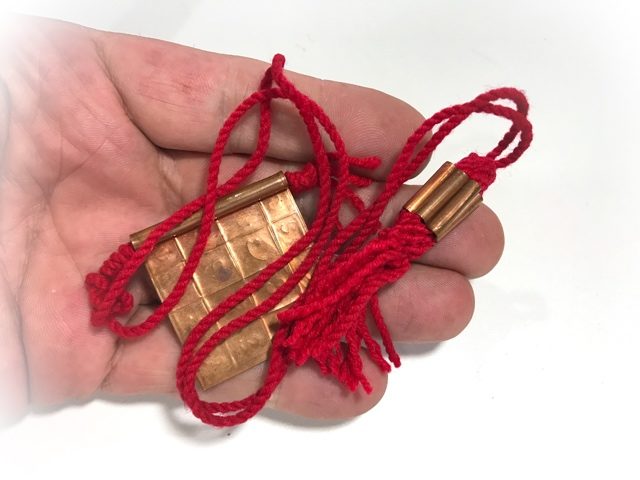
Kroo Ba Wang was renowned for so many different kinds of amulets, ranging from his Takrut (especially the Takrut Gao Gum and cord-bound spells, his famous In Ma, In Koo, Paya Khao Kam, Pa Yant, Pra Rahu, and Guru Monk Coins, all of them being purely belonging to the Lanna Traditional Wicha.
Luang Phu Kroo Ba Wang is Legendary for his Maha Sanaeh Magic, was one of the most famous of the Northern Lanna Guru Masters of the Olden Days. Highly preferred for his In Koo, Pra Rahu, and Pha Yant Sacred Geometry yantra Cloth Spells. Of the Pha Yant he was especially renowned for his Pha Yant Ma Saep Nang Lady-Horse images.
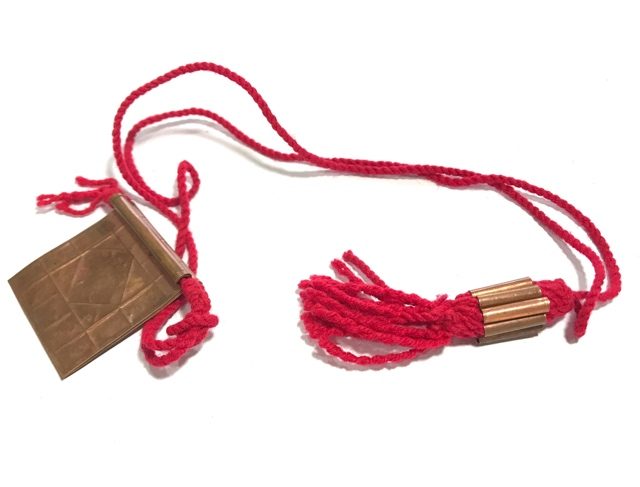
Luang Phu was born in 2434 BE, in the country into a family of farmers and market traders, In those days, the only way to get any schooling in the countryside was to stay in a temple and learn with the Monks, and so, at the age of nearly 9 years old, his father took him to live at the nearby temple, to learn to read and write. After about 3 years. Luang Phu could read and write fluently enough, and so he was able to ordain into the Sangha as a Samanera Novice Monk in the year 2445 BE
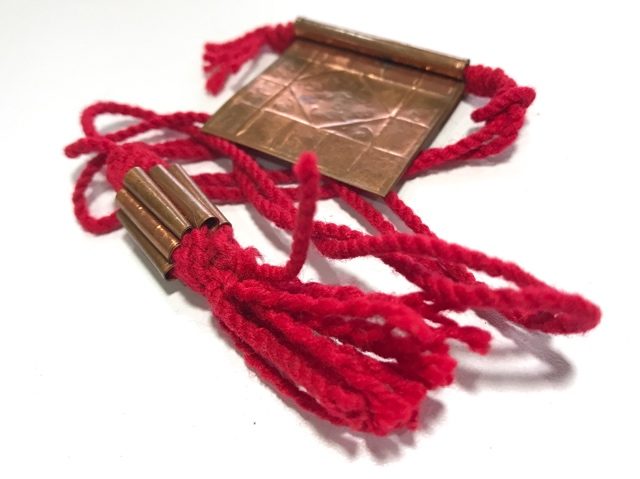
Luang Phu reached the age to be ordained as a fully fledged Bhikkhu in the Buddha Sasana in the year 2455 and was ordained on the 5th of May of that year as a Bhikkhu, at 13:15 hours at Wat Ban Baen Temple. Luang Phu then began to practice Khom Sanskrit Agkhara and Wicha, and within a very short period of time became so adept that he could chant every single line of Agkhara from memory with great aptitude.
Pra Kroo Gantiya was his Upachaya Ordaining Officer, and Pra Ajarn Bpan was his Pra Gammawājājarn (Prompter). Pra Atigarn Bpum was his Pra Anusawanājarn (Witness). Luang Phu was given the Chāyā (official Monks Name) of Prohma Sēno. Luang Phu Kroo Ba Wang then stayed on at Wat Ban Baen in Lampoon for a period of 2 years more. After this, Luang Phu Kroo Ba Wang then moved to stay at Wat Ban Hmueang Jee, which was in his home area where he was born.
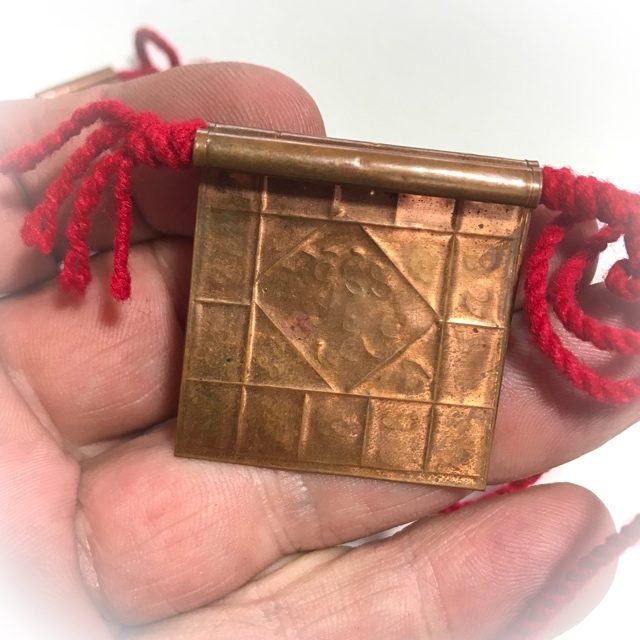
Luang Phu then continued to study and practice Wicha Akom and Khom Agkhara, for a further three years, until he became inspired to take up the practice of Tudong Solitary Forest wandering, and gain experience in Kammathana.

Luang Phu then travelled through the thick forest area of Pha Teub, on is way towards Chiang Saen, and stopped in the forest to practice for 6 months. Once he reached Chiang Saen, he stayed around the area practicing for some years, until he decided to travel towards Prae Province, where he finally arrived and stayed at the temple of Wat Den Chai.
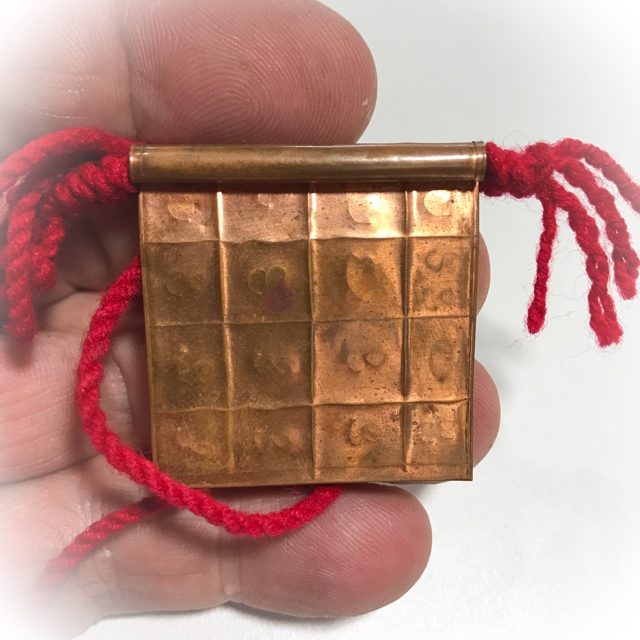
He stayed at this temple to master the various Sorcert Methods of the Region, so that he would be able to perform Powerful Incantations enabling him to cast spells and blessings to offer protection, happiness and prosperirty to the fold, and to send metta and merits to the Nature Spirits of the Nether Worlds, with Compassionate Mercy Magic.
Once he had mastered this Wicha, he then set forth once more, and practiced Tudong, until he came to rest at a very peaceful place in the forest called ‘Pha Den Gradtay’, which was very auspicious in energy. There was a small village nearby which was impoverished, and Luang Phu then decided to build a temple with the help of the locals. But Luang Phu was first called back by locals of the temple at Wat Dton Tong, so he agreed and went backl to assist the with their needs.
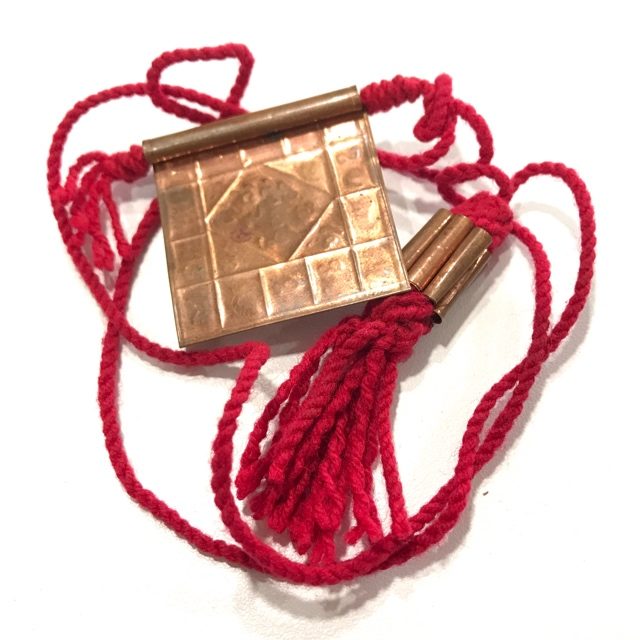
After one year helping them, he was able to return to Pha Den Gradtay, and built three Kuti Huts and invited some other monks to come and stay, and assist in developing the temple. Then in the yeat 2508 Luang Phu Kroo Ba Wang began to build the Uposadha Shrine Room and the locals of the surrounding areas began to hear of his merits, and flock to the temple to make donations and assist.
The Uposadha was then finished in the the year 2510 BE. Luang Phu became famous for both is great ability to finish the temple of Wat ban den in Miraclulously short timespan, and also for his many Wicha, including Horasart (Astrology), Amulet making, Maha Sanaeh and Metta Maha Niyom Maha Lap Magic, and his ability to use Candle Magic to eliminate Bad Karma.

In the year 2513, time caught up with Luang Phu and he became ill, and began to weaken with age, and became unable to travel, and stayed for the rest of is life until his passing at Wat Ban Den in the year 2516 BE
